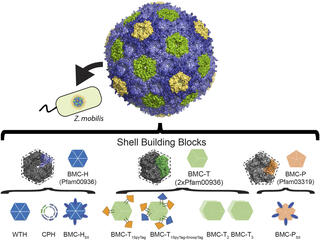Microcompartments could give industrial microbes space for challenging reactions

Background/Objective
Many bacteria use self-assembling, protein-based organelles to form a semipermeable barrier that keeps out toxic or volatile intermediates while allowing substrates and products to pass through. Such microcompartments could be used to encapsulate non-native enzymes and incorporate challenging metabolic pathways into industrially relevant bacteria such as Zymomonas mobilis.
Approach
Using synthetic biology, researchers introduced a model shell system derived from the myxobacterium Haliangium ochraceum (HO shell) into Z. mobilis with the goal of constructing a microcompartment-based spatial scaffolding platform as a next-generation tool for metabolic engineering.
Results
Three analytical techniques (SDS-PAGE, transmission electron microscopy, and dynamic light scattering analysis) confirmed the ability to express and purify empty capped and uncapped HO shells in Z. mobilis and to simultaneously target proteins of interest to their interior and exterior surfaces.
Impact
Microorganisms like Z. mobilis can be used to produce sustainable biofuels and other products, but attempts to modify their metabolisms can result in accumulation of toxic intermediates or unwanted metabolic cross-talk. Self-assembling, easy-to-modify, protein-based microcompartments offer a sophisticated way to overcome these obstacles by acting as an autonomous catalytic module decoupled from the cell’s regulatory and metabolic networks.
The ability to encapsulate proteins of interest in microcompartments and control the orientation of the cargo enzymes provides a foundation for incorporating enzymes and microcompartments with synthetic biological pathways for production of high-value products in Z. mobilis.